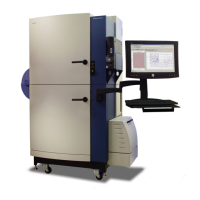Calibration and Signal Test
152 0112-0109 H
Coumarin
1. Required material:
Black clear-bottom plate of desired format and brand for
assay (96, 384, or 1536).
Coumarin (7-diethylaminocoumarin-3-carboxylic acid, Cat#
D-1421, Molecular Probes, Eugene, OR)
2. Make a 0.02 M stock solution of Coumarin in Dimethyl Sulfoxide
(DMSO). Mix by vortexing tube.
3. Store small aliquots at -20 °C.
4. Within one hour of calibration, thaw an aliquot and make 20 mL
10
-5
M solution in the same buffer to be used for dye loading.
Adjust pH to 7.4. Mix by vortexing.
5. Pipette a uniform quantity of the Coumarin solution into each
well of the microplate. The volume must be adequate to cover
the bottom of the well uniformly. The following quantities are
recommended:
96-well plate, 100 μL/well
384-well plate, 40 μL/well
1536-well plate, 6 μL/well
6. Check the plate visually to make sure there are no bubbles or
unfilled wells. Shake or tap the microplate to dislodge any
bubbles. Keep the Coumarin plate covered and in the dark until
used.
7. Use the Coumarin plate as the Flat Field Calibration Plate in
step 7 in Recalibrating the Optics on page 150.
MQAE
1. Required material:
Black clear-bottom plate of desired format and brand for
assay (96, 384, or 1536).
MQAE (N-(ethoxycarbonylmethyl)-6-methoxyquinolinium
bromide) Catalog
# E-3101, Molecular Probes, Eugene, OR)
2. Make a 0.02 M stock solution of MQAE in distilled water. Mix by
vortexing tube.
3. Store small aliquots at -20 °C.
4. Within one hour of calibration, thaw an aliquot and make 20 mL
10
-5
M solution in water or in a chloride-free buffer to be used
for dye loading. Adjust pH to 7.4. Mix by vortexing.
5. Pipette a uniform quantity of the MQAE solution into each well of
the microplate. The volume must be adequate to cover the

